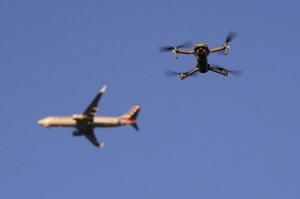Drones pose increasing risk to airliners near major US airports
[April 21, 2025]
By AARON KESSLER and MICHAEL BIESECKER
WASHINGTON (AP) — A commercial airliner was on final approach to San
Francisco’s international airport in November when the crew spotted a
drone outside the cockpit window. By then it was too late “to take
evasive action,” the pilots reported, and the quadcopter passed by their
windshield, not 300 feet away.
A month earlier, a jetliner was flying at an altitude of 4,000 feet near
Miami’s international airport when its pilots reported a “close
encounter” with a drone. In August, a drone came within 50 feet of
clipping the left wing of a passenger jet as it departed Newark
International Airport.
The incidents were all classified as “near midair collisions” — any one
of which could have had catastrophic consequences, according to aviation
safety experts. They were also not isolated encounters.
An Associated Press analysis of an aviation safety database reveals that
drones last year accounted for nearly two-thirds of reported near midair
collisions involving commercial passenger planes taking off and landing
at the country's top 30 busiest airports. That was the highest
percentage of such near misses since 2020, when air traffic dropped
during the COVID-19 pandemic.
The first reports of near misses involving drones were logged in 2014,
the AP found. The number of such encounters spiked the following year.
Over the last decade, drones accounted for 51% — 122 of 240 — of
reported near misses, according to AP's analysis.
Passenger jets have long been subject to risks around airports — whether
from bird strikes or congested airspace — as was made clear by the
January collision between a military helicopter and commercial jet near
Washington, D.C., that killed 67 people.

The threat has become more dire
The threat from drones has become more acute in the last decade as the
use of quadcopters and remote-controlled planes has exploded in
popularity. The FAA estimates that Americans are operating more than a
million drones for recreational and commercial purposes.
“If you have the money, you can go on the internet and buy a pretty
sophisticated drone that can reach altitudes they really have no
business being at,” said William Waldock, a professor of safety science
at Embry-Riddle Aeronautical University.
The risk is most acute near airports because that is where the flight
paths of drones and airplanes most overlap, experts said.
The incidents represent only a portion of such close calls because the
database — NASA’s Aviation Safety Reporting System — relies on voluntary
submissions from pilots and other aviation workers. A separate FAA
program, which includes reports from the public, tallied at least 160
sightings last month of drones flying near airports.
“The FAA recognizes that urgency, and we all know additional changes
need to be made to allow the airports to go out and detect and mitigate
where necessary,” said Hannah Thach, executive director of the
partnership, known as Alliance for System Safety of UAS through Research
Excellence.
FAA says it is taking steps to improve safety
The FAA said it has taken steps to mitigate the risks of drones. It has
prohibited nearly all drones from flying near airports without prior
authorization, though such rules are difficult to enforce, and
recreational users may not be aware of restrictions.
The agency requires registrations for drones weighing more than 250
grams (0.55 pounds), and such drones are required to carry a radio
transponder that identifies the drone’s owner and broadcasts its
position to help avert collisions. Additional rules govern commercial
drone use.

[to top of second column]
|

A drone hovers in airspace outside the safety perimeter surrounding
St. Louis Lambert International Airport as an airliner approaches
for a landing on March 10, 2025. (AP Photo/Jeff Roberson)

The agency has also been testing systems to detect and counter
drones near airports. Among the methods being examined: Using radio
signals to jam drones or force them to land. Authorities are also
weighing whether to deploy high-powered microwaves or laser beams to
disable the machines.
Experts said the FAA and other authorities could do more. They
suggested creating a system similar to speed cameras on roadways
that could capture a drone’s transponder code and send its pilots a
ticket in the mail.
They also said the FAA should consider regulations that require all
manufacturers to program a drone’s GPS unit to prevent it from
flying near airports and other sensitive areas, a method called “geofencing.”
Drone manufacturer ends mandatory 'geofencing’
DJI, a leading drone maker, used such geofencing restrictions for
years. However, it eliminated the feature in January, replacing it
with an alert to drone pilots when they approach restricted areas.
Adam Welsh, head of global policy at DJI, said managing requests
from authorized users to temporarily disable the geofencing became
an increasingly time-consuming task. More than one million such
requests were processed last year.
“We had around-the-clock service, but the number of applications
coming in were becoming really hard to handle,” Welsh said. “They
all had to be reviewed individually.”
With no other manufacturers enabling geofencing, and without
government rules requiring it, DJI decided to end the practice, he
said.
The FAA declined to say if it is considering whether to mandate
geofencing.
Drone users can face consequences
Experts said authorities should take more aggressive action to hold
drone users accountable for violating restricted airspace — to
highlight the problem and deter others from breaking the rules,
pointing to recent arrests that they hoped might send such a
message.
In December, for example, Boston police arrested two men who
operated a drone that flew dangerously close to Logan International
Airport. Police reported that they were able to find the drone
flyers, in part, by tracking the aircraft thanks to its FAA-mandated
transponder signal.

A month later, a small drone collided with a “Super Scooper” plane
that was fighting wildfires raging through Southern California. The
drone punched a hole in the plane's left wing, causing enough damage
that officials grounded the aircraft for several days to make
repairs.
Authorities tracked down the 56-year-old drone operator, who pleaded
guilty to a federal charge of recklessly flying his aircraft. The
man, who has yet to be sentenced, admitted he launched his DJI
quadcopter to observe fire damage over the Pacific Palisades
neighborhood, despite the FAA having restricted drone flying in the
area, according to court records. The operator lost sight of the
drone after it flew about 1.5 miles from where he had launched it.
And that's when it struck the “Super Scooper."
All contents © copyright 2025 Associated Press. All rights reserved |